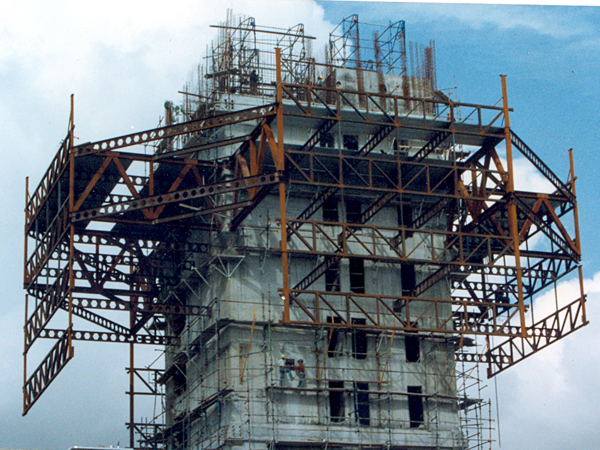The formulation of an official improvement and expansion program for the IST facilities dates from the final seventies, program that guided a Master Plan formulation, in which, and with the adjustments that the passing time had introduced, being a support to the new facilities’ design, amongst which the following are mentioned, for their importance and volume: the Civil Engineering Pavilion, in the meantime almost complete, and the one for the Post Graduation School, in a starting-up stage.
The referred “North Block” building is located between the primitive Electricity and Mechanics Pavilions, as it was mentioned in the Plan along with a similar building to locate between the Chemistry and Mines. It was that conception that was recovered, with some adjustments.
The Institute’s Improvement and Expansion Master Plan had an inherent aesthetic part that can, briefly, be characterized by its intent to maintain the initial outlines, mainly in what concerns the spaces and buildings located between the Central Pavilion and Alameda de Afonso Henriques’ outset, leaving to the new buildings the zone that develops between this pavilion and the Alves Redol Street, on account of the long previous existence of an architecturally differentiated building, the Interdisciplinary Complex.
For this reason, the planned and implemented interventions in the East Central Pavilion were designed in shapes that would not disturb the angles of the initial design, especially the ones related to great Central Lane.
This building, which cannot be separated from the other one with the same expression and volume between the Chemistry and Mine’s Pavilions, is located, directly in the areas that are intended to be preserved.
Indeed, as considered at the time of the Master Plan’s formulation, the idea was that that these buildings would be composed by a lower element, located between the existent buildings, and architecturally harmonized with them, and by a superior one, detached from the basis’ set, formally very simple and lined with glass, rather mirrored, so that it would reflected the sky and early buildings in order to be appreciated.
The lower element, by filling the space between the existent pavilions, deletes the patios located there, which were actually previously occupied with temporary buildings.
According to the formal and structural features, the building is composed by two different elements:
– One, lower, with three floors, occupying the interstitial spaces between the Electrotechnology and Mechanics Departments;
– Another, superior, in a square shape, with eight floors, developed on top of those pavilions, composed by a central core, where the downright circulation columns (stair and lifts), “courettes” and toilets, circled by offices, are located.
The LOWER ELEMENT was reserved for the common use large spaces, such as lobbies, foyers, amphitheatres, management and administrative services, library, etc.
The SUPERIOR ELEMENT is composed by eight floors (floors 4 to 11) defining itself as a different architecturally part different from the basis composed by the Lower Element, which in turn, on its plastic form, will establish the necessary connection with the existent pavilions.
Structurally, it is formed by the resistant central core, in reinforced concrete, supporting, in the 4 and 9 floor level, large metal beam sets, with a corresponding height to the floor, the will, on their turn, be supported by the other floors.
Owner:
Instituto Superior Técnico
Universidade Técnica de Lisboa
Location:
Afonso Henriques’ Lane
Lisbon
Construction Area:
10.000m²
Project:
1993
Conclusion:
1995
Program:
Overall Project of a building directed to research and education, to be built in the IST’s enclosure, between the Electrotechnology and Mechanics Pavilions, encompassing various facilities such as four amphitheatres, classrooms, teaching and researching laboratories, offices, researching institutes, etc.
Team:
Architecture
– Manuel Cottinelli Telmo Pardal Monteiro – Architect
– João Cottinelli Telmo Pardal Monteiro – Architect
– António Pedro Batista Pardal Monteiro – Architect
– Paulo Vasco Silva Antunes – Architect
– Amadeu Lourenço
– Rodrigo Moutinho
Foundations and Structure
– Paulo Reis – Engineer
Mechanical Equipment and Facilities
– GPF – Grupo Português de Frio
Water and Sewage Equipment and Facilities
– Grade Ribeiro – Engineer
Electrical and Telecommunications Equipment and Facilities
– GPF – Grupo Português de Frio





